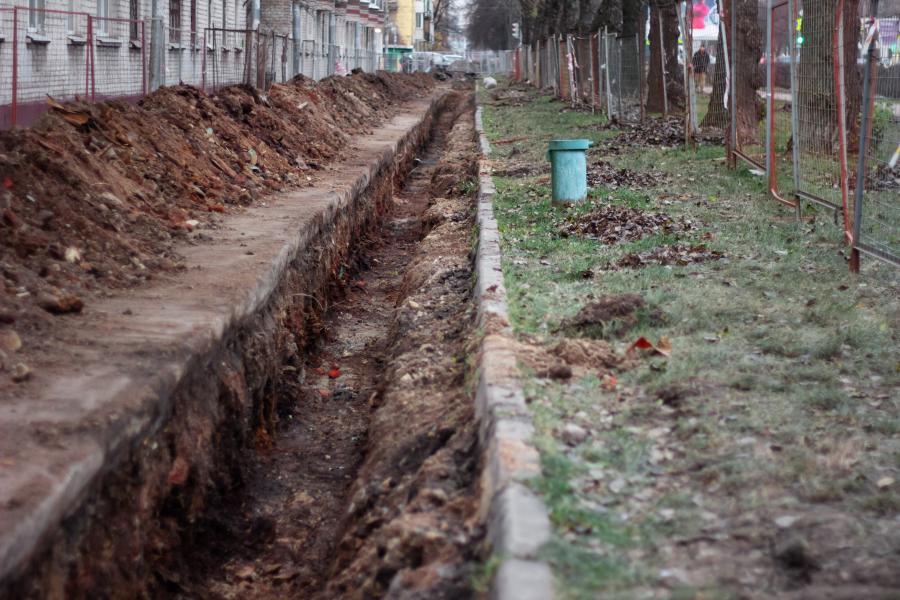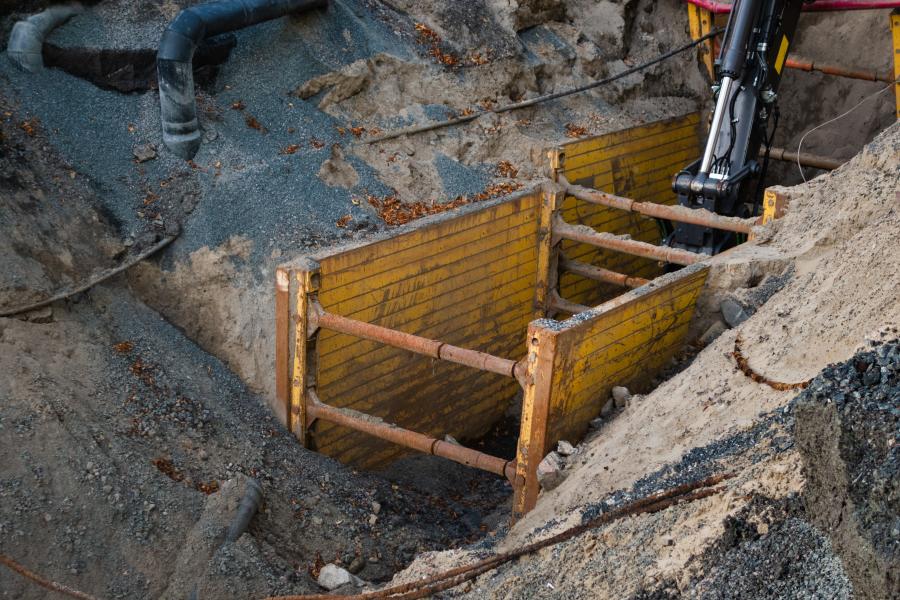Inspect [at the start of each and end of shift], and any occurrence of an event that may have compromised trench condition. Also, keep excavated soil, materials and equipment at least 2 ft. from trench edges.
Did you know that in 2019, excavation and trenching violations were some of the most-expensive OSHA citations? Among the most dangerous construction-related activities, trenching accidents represented the tenth highest penalty issued by the federal agency last year. OSHA's rules for trenching and excavation safety are part of its efforts to ultimately eliminate these statistics, and outreach programs include sponsorship of a safety stand down initiative, scheduled for June.
Providing the COVID-19 health crisis is behind us by then, the 2020 Trench Safety Stand Down is set for June 15 to 19 and includes safety summits, classroom training, outdoor demonstrations and mock trench rescues. The idea is to reinforce the importance of using trench protective system and protecting workers from trenching hazards, according to the National Utility Contractors Association (NUCA), a stand-down co-sponsor.
Other organizations, such as the North American Excavation Shoring Association (NAXSA), and the Trench Shoring and Shielding Association (TSSA), are participating in the stand down, which "presents the opportunity for employers to talk directly to employees and others about safety," according to the National Utility Contractors Association (NUCA).
The goal is to provide as many people as possible who work in and around trenches and excavations with information about current excavation requirements and safety procedures for working in trenches.
"By reaching as many workers as possible we can reduce the number of fatalities and serious injuries that occur each year in our industry, and make others, such as municipal and industry workers who are also exposed, aware of these serious hazards," according to NUCA. The organization encourages utility construction, residential, highway construction, plumbers, military, unions, associations, educational institutes and safety equipment manufacturers to participate.
Who's Competent to Decide?
OSHA preaches that safe and proper trenching operations can reduce worker exposure to cave-ins, falling loads, hazardous atmospheres and hazards from mobile equipment. The agency's standards require that before work begins a competent person inspect trenches and protective systems daily and as conditions change.
A trench safety pocket card distributed by the federal safety agency urges construction crews to never enter a trench unless it has been properly inspected by a competent person who has also made sure cave-in protection measures are in place; they've determined there is a safe way to enter and exit; they've made sure equipment and materials are away from the edge; and that the area is free of standing water and atmospheric hazards.
To prevent trench collapses, trenches 5 ft. deep or greater require a protective system. However, trenches 20 ft. deep or greater require a protective system designed by a registered professional engineer. Last summer, OSHA created a free sticker explaining the three primary protective systems: Slope, shore and shield.
A construction crew should slope or bench trench walls by cutting back the trench wall at an angle inclined away from the excavation. They should shore the trench walls by installing aluminum hydraulic or other types of supports to prevent soil movement. Trench walls can be shielded with trench boxes or other types of supports to prevent soil cave-ins.
Civil Engineer Bill Brewer points out that because no two trenching jobs or trenches are alike, the factors and conditions affecting a trench differ. These factors and conditions can include the site, adjacent structures, above-ground and buried utilities, trees, soil type and structure, ground water levels, weather, external loading or surcharge, required width and depth of the trench, type of work/installation, duration of the work, site constraints/space limitations, access to the site, previous disturbance of the soil, etc.
In an article for Robson Forensics, Brewer wrote that OSHA regulations and industry standards require all employees performing trench work to be trained in hazard recognition. The agency also requires that a competent person must make the determination about trench conditions and appropriate protective system. A ‘competent person' is defined as someone capable of identifying existing and predictable hazards, and who has the authority to take corrective measures.
In a 2019 blog post on trenching and excavation safety, the National Association of Safety Professionals offers a list of questions a competent person should ask during a site assessment, which include:
- Is the cut, cavity or depression a trench or an excavation? Is it more than 4 ft. deep? Does it contain water?
- Are there adequate means of access and egress? Are there surface encumbrances or exposures to vehicular traffic? Are adjacent structures stabilized?
- Is equipment operating near the trench or excavation? Does the equipment have warning systems?
- Does the trenching or excavation work require sloping, shoring, or shielding? If shielding is used, does the shield extend at least 18 in. above the surrounding area if it is sloped toward the excavation? Is the depth of the cut more than 2 ft. below the bottom of the shield?
- Is emergency rescue equipment required?
- Is there documentation of the minimum daily excavation inspection?
"It's extremely important to have a competent person on the job," George Kennedy, NUCA vice president of safety, said in the NASP blog, "because they're going to make sure that they are using their protective system, that it is set up properly. And they're making sure workers don't take chances, ladders are set up, [excavated soil] piles are set back at least 2 feet from the edge of the excavation. All the things that go along with making sure the trench is safe before a worker goes into it."
Trenching Best Practices
To avoid trenching accidents, the designated competent person should do his or her homework. Knowledge is king, and knowing all of OSHA's trenching and excavation safety regulations, along with industry best practices, helps keep operations incident-free. Trench protection specialists Griswold Machine & Engineering (GME), Union City, Mich., has solid advice for avoiding trench accidents, starting with homework.
"Get ready to dig," advises GME: "Not just in the ground, but dig through the basic regulations and guidelines before you start a project. Scope it out."
The trench shield and shoring equipment producer believes the rules and regulations are there for a reason.
"If you want to prevent trenching accidents, and everyone should, then don't get in too deep without the right knowledge (and equipment)."
With knowledge, you can ask questions and get a sense about certain circumstances that threaten the safety of those on the job site, GME urges.
"Ground conditions make a big difference in how you treat a job and how wary you have to be of additional potential for danger … It matters whether you have sand, dirt, rocky mix or something else. Beyond that, recent weather patterns like wind and precipitation also matter greatly."
Learn all you can about the equipment involved in trench shielding and shoring. Using the wrong equipment — or using the right equipment the wrong way — can have bad results. Work with an equipment provider that will also offer you the right information and advice on best practices for your jobsite. Other tips from GME:
- Inspect Trenches — at the start of each shift, at the end of each shift and when an event occurs that may have compromised the trench's condition.
- Keep excavated soil, materials and equipment at least 2 ft. from trench edges.
- Have access to ladders or egresses. There must be a least one safe, unimpeded way to get in and out of an excavation within 25 ft. of each worker.
- Have workers wear high-visibility safety clothing.
Finally, GME believes the biggest move you can make is to "develop the right mindset. The ideal is to have zero incidents on site and to have no fines from regulatory authorities like OSHA. Everyone wins when this ideal is made a reality." Don't ignore the risk, the blog's author stressed. "Recognize that you'll spend much more time and money in response to something that goes wrong." CEG
Lucy Perry
Lucy Perry has 30 years of experience covering the U.S. construction industry. She has served as Editor of paving and lifting magazines, and has created content for many national and international construction trade publications. A native of Baton Rouge, Louisiana, she has a Journalism degree from Louisiana State University, and is an avid fan of all LSU sports. She resides in Kansas City, Missouri, with her husband, who has turned her into a major fan of the NFL Kansas City Chiefs. When she's not chasing after Lucy, their dachshund, Lucy likes to create mixed-media art.
Read more from Lucy Perry here.
Today's top stories



![Inspect [at the start of each and end of shift], and any occurrence of an event that may have compromised trench condition. Also, keep excavated soil, materials and equipment at least 2 ft. from trench edges.](https://dmt55mxnkgbz2.cloudfront.net/900x0_s3-48079-1s3-48079-MNSW-102_20-LP-100.jpg)
![Inspect [at the start of each and end of shift], and any occurrence of an event that may have compromised trench condition. Also, keep excavated soil, materials and equipment at least 2 ft. from trench edges.](https://dmt55mxnkgbz2.cloudfront.net/0x76_s3-48079-1s3-48079-MNSW-102_20-LP-100.jpg)










